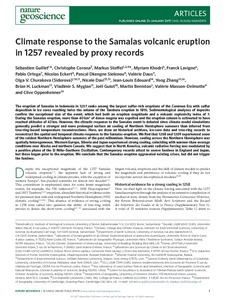Показать сокращенную информацию
Climate response to the Samalas volcanic eruption in 1257 revealed by proxy records
| Автор | Guillet, S | |
| Автор | Corona, C | |
| Автор | Stoffel, M | |
| Автор | Khodri, M | |
| Автор | Lavigne, F | |
| Автор | Ortega, P | |
| Автор | Eckert, N | |
| Автор | Sielenou, Pd | |
| Автор | Daux, V | |
| Автор | Churakova (Sidorova) O | |
| Автор | Davi, N | |
| Автор | Edouard, Jl | |
| Автор | Masson-Delmott, V | |
| Автор | Oppenheimer, C | |
| Дата внесения | 2018-02-07T07:27:00Z | |
| Дата, когда ресурс стал доступен | 2018-02-07T07:27:00Z | |
| Дата публикации | 2017-02 | |
| Библиографическое описание | Guillet, S. Climate response to the Samalas volcanic eruption in 1257 revealed by proxy records [Текст] / S Guillet, C Corona, M Stoffel, M Khodri, F Lavigne, P Ortega, N Eckert, Pd Sielenou, V Daux, Churakova (Sidorova) O, N Davi, Jl Edouard, V Masson-Delmott, C Oppenheimer // Nature Geoscience. — 2017. — Т. 10 (№ 2). — С. 123-128 | |
| ISSN | 17520894 | |
| URI (для ссылок/цитирований) | http://www.nature.com/ngeo/journal/v10/n2/full/ngeo2875.html?foxtrotcallback=true | |
| URI (для ссылок/цитирований) | https://elib.sfu-kras.ru/handle/2311/69686 | |
| Описание | Текст статьи не публикуется в открытом доступе в соответствии с политикой журнала. | |
| Аннотация | The eruption of Samalas in Indonesia in 1257 ranks among the largest sulphur-rich eruptions of the Common Era with sulphur deposition in ice cores reaching twice the volume of the Tambora eruption in 1815). Sedimentological analyses of deposits confirm the exceptional size of the event, which had both an eruption magnitude and a volcanic explosivity index of 7. During the Samalas eruption, more than 40 km3 of dense magma was expelled and the eruption column is estimated to have reached altitudes of 43 km. However, the climatic response to the Samalas event is debated since climate model simulations generally predict a stronger and more prolonged surface air cooling of Northern Hemisphere summers than inferred from tree-ring based temperature reconstructions. Here, we draw on historical archives, ice-core data and tree-ring records to reconstruct the spatial and temporal climate response to the Samalas eruption. We find that 1258 and 1259 experienced some of the coldest Northern Hemisphere summers of the past millennium. However, cooling across the Northern Hemisphere was spatially heterogeneous. Western Europe, Siberia and Japan experienced strong cooling, coinciding with warmer-than-average conditions over Alaska and northern Canada. We suggest that in North America, volcanic radiative forcing was modulated by a positive phase of El Niño-Southern Oscillation. Contemporary records attest to severe famines in England and Japan, but these began prior to the eruption. We conclude that the Samalas eruption aggravated existing crisis, but did not trigger the famines. | |
| Тема | Samalas | |
| Тема | volcanic eruption | |
| Тема | Northern Hemisphere | |
| Название | Climate response to the Samalas volcanic eruption in 1257 revealed by proxy records | |
| Тип | Journal Article | |
| Тип | Published Journal Article | |
| Страницы | 123-128 | |
| ГРНТИ | 38.37.25 | |
| Дата обновления | 2018-02-07T07:27:00Z | |
| DOI | 10.1038/NGEO2875 | |
| Институт | Институт экологии и географии | |
| Подразделение | Лаборатория биогеохимии экосистем | |
| Подразделение | Научно-исследовательская часть | |
| Журнал | Nature Geoscience | |
| Квартиль журнала в Scopus | Q1 | |
| Квартиль журнала в Web of Science | Q1 |

